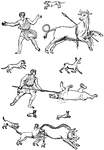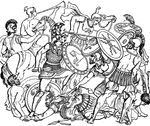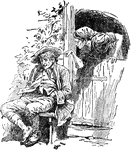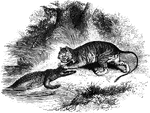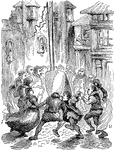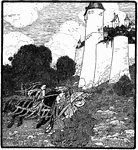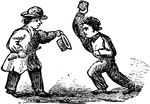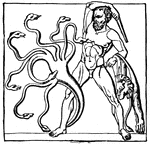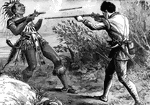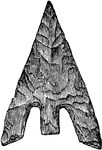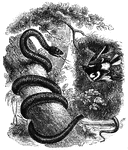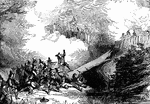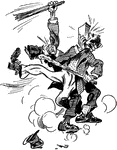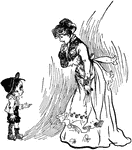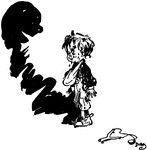Clipart tagged: ‘fight’
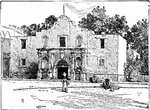
The Alamo
The Battle of the Alamo was fought in February and March 1836 in San Antonio, Texas. The conflict, a…
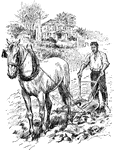
After Appomattox
The Appomattox Campaign (March 29, 1865 – April 9, 1865) was a series of battles fought in Virginia…

Battle of Azincourt
The Battle of Agincourt was an English victory against a larger French army in the Hundred Years' War.…

Battlefield
A battlefield refers to the location of a battle. Generally, a battle is a conceptual component in the…

Egyptian Boatmen Fighting
Brawl among Egyptian boatmen. Carving from the tomb of Ptah-hetep during the Pyramid age.

Boxing
"The Olympic games were of greater efficacy than the Amphictyonic Council in promoting the spirit of…

Battle of Charles City
"Battle of Charles City Road- charge of the Jersey Brigade- the first New Jersey brigade, General Tayler,…
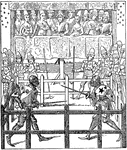
Trial by Combat
"The trial by combat, or wager of battle, was a solemn judicial duel. It was resorted to in the belief…

Constantinople
An illustration of the fortification around Constantinople and soldiers firing cannons.

Duel Between Aaron Burr and Alexander Hamilton
A duel between Alexander Hamilton and Aaron Burr, in which Hamilton was killed.
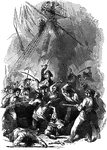
Fight on the Deck of the Serapis
The Serapis was a British frigate that was captured by the Americans during the American Revolutionary…
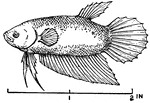
Fighting Fish
Betta pugnax, also known as the Fighting Fish (on account of its pugnacious habits), is a bony fish…
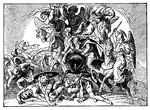
Five Angelic Warriors Fight for the Maccabees
Illustration of the Maccabee warriors fighting alongside angelic warriors in a swirl of battle. The…
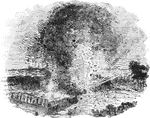
Blowing Up Fort Hill Bastion
As June wore on, Grant pressed the siege with vigor. Johnston tried to help Pemberton, but could not.…

Gladiators
This illustration shows various types of gladiators, each type with with his specific weapons attributed…
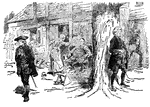
A Group of People
A group of people interacting in front of a house. One man is hiding behind a tree and another is walking…
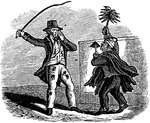
If You Quarrel with a Sweep, You'll Get Blackened
"A chimney sweep hath some offense here given, / The foolish man is to fierce anger driven; / The urchin…
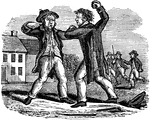
It Costs More to Revenge Injuries than to Bear Them
"See these poor fools into anger falling, / What hateful raging, tearing, mauling; / And all for what?…

Two Knights Jousting with Lances
An illustration of two knights jousting with lances, shields, and armor.
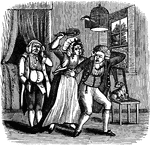
Let Other People's Quarrels Alone
"A man and wife, by liquor strong inspired, / Have come to blows, with hateful anger fired: / A humane…
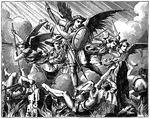
Lucifer's Fall from Heaven - Michael and Other Angels Fight Against the Vanquished Angels
"How art thou fallen from heaven, O day-star, son of the morning! how art thou cut down to the ground,…
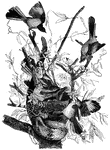
Mockingbirds Attacking a Rattlesnake
A flock of mocking-birds attacking a rattlesnake in a tree, which was threatening a nest.
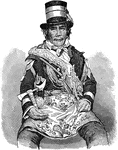
Oshawahnah
Tecumseh's deputy commander who led the Indians against American forces at the Battle of the Thames

Reynard the Fox: Fighting the Wolf
Reynard the Fox and Isegrim the wolf fight each other. Reynard kicks dirt and sand up in Isegrim's eyes.

Reynard the Fox: Reynard's Victory
Reynard the Fox and Isegrim the wolf fight each other. Reynard outsmarts him and knocks him down.
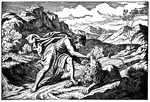
Samson Tears a Lion Apart with His Bare Hands
"Then went Samson down, and his father and his mother, to Timnah, and came to the vineyards of Timnah:…
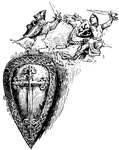
Medieval Shields from the 13th and 14th Centuries
Illustration including one large shield from the first half of the 13th century, bearing a decorative…
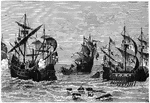
Spanish & English Ships with Sails at War
An illustration of Spanish and English ships with sails at war.
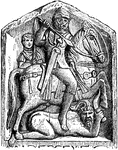
Sueve and Roman Rider
A Roman rider battling a Sueve. Suevi were Germanic people that posed a threat to the Romans.

Appearance of the Thames Battle Ground in 1860
The Battle of the Thames, also known as the Battle of Moraviantown, was a decisive American victory…

The Worth of a Thing is Known by the Want of It
"See here three men engaged in mortal strife; / Two fell assassins seek the lone man's life, / But he,…
Ticonderoga and the Lake, from Mount Defiance
The crossing between Lakes George and Champlain had been used by natives for thousands of years. The…

Tippecanoe Battle Ground in 1860
The Battle of Tippecanoe was fought in 1811 between United States forces led by Governor William Henry…
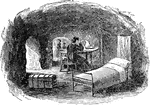
Cave Life in Vicksburg
During the siege, Union gunboats lobbed over 22,000 shells into the town and army artillery fire was…
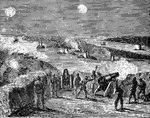
Porter's Fleet Shelling the Batteries Vicksburg
Union forces bombarded the city all night, from 220 artillery pieces and naval gunfire from Rear Adm.…
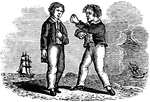
Where One Will Not, Two Cannot Fight
"One of the boys appears in desperate case; / He thrusts his fists into his playmate's face: / His playmate…

Wyoming Valley Massacre
The Battle of Wyoming was an encounter during the American Revolutionary War between American Patriots…
British Works at Yorktown
The Siege of Yorktown or Battle of Yorktown in 1781 was a decisive victory by a combined assault of…
